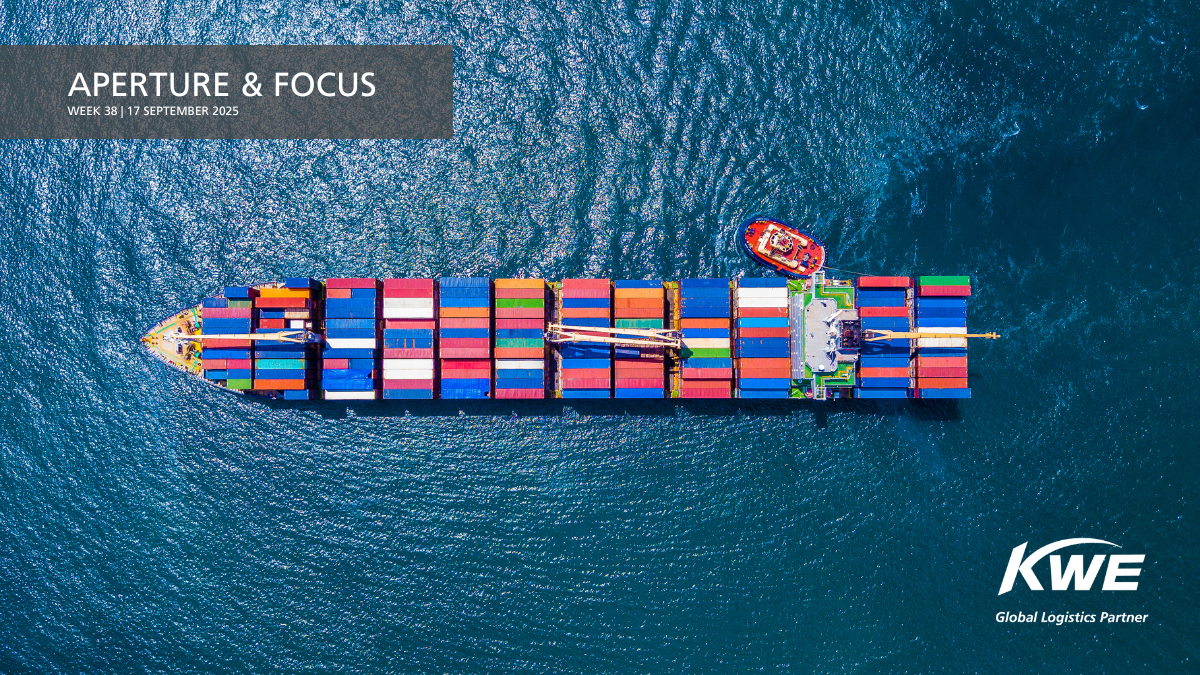Quote
Aperture & Focus 2025: Week 38

Global Aperture
A September 15th report from Sea-Intelligence shows empty containers now account for 41% of global container shipping capacity, up from 31% in 2019, as persistent trade imbalances and blank sailings leave boxes stranded in some regions and scarce in others. This growing imbalance is creating storage bottlenecks, delaying cargo flows, and adding costs and inefficiencies across global supply chains.
Global airfreight demand saw its strongest growth since April 2025, led by Europe and intra-Asia routes, with resilience driven by added belly hold capacity, sector-specific growth in pharmaceuticals and e-commerce, and investments in sustainable cold chain technology. At the same time, freighter shortages, labor disputes, weather disruptions, and regulatory shifts such as proposed pilot retirement age changes continue to challenge capacity, reliability, and long-term planning across regions.
Regional Focus
Americas
United States: The Port of Long Beach recorded its second-busiest August ever, handling 901,846 TEUs as retailers front-loaded shipments ahead of tariff changes, bringing year-to-date volumes up 8.3% versus 2024. Despite this strong performance, forecasts point to steep year-over-year declines through year-end as tariff uncertainty, falling container rates, and global oversupply continue to disrupt trade patterns.
Georgia Ports has introduced a new “lay berth” system at the Port of Savannah, allowing vessels to temporarily dock at Ocean Terminal before moving to Garden City Terminal once a berth is available. The initiative, first used on September 11, 2025, is expected to handle two additional ships per week and cut berth idle time from up to 15 hours to as little as three.
Mexico: The United States Department of Transportation has taken enforcement action against Mexico’s 2023 policy moving U.S. all-cargo carriers from Mexico City International Airport to Felipe Ángeles International Airport, issuing Part 212 and Part 213 orders and a show-cause order to withdraw Delta–Aeromexico’s antitrust immunity. The shift has raised transit times and costs for U.S. exporters, cut Mexico’s total air cargo volumes by 5.2% in the first half of 2025, and sparked concerns over supply chain reliability, competitive access, and trade stability under the United States–Mexico–Canada Agreement.
Asia-Pacific
Asia’s air cargo is expanding with major capacity gains—Hong Kong International Airport handled about five million tonnes in 2024, Singapore Changi Airport is raising capacity to 5.4 million tons, and Vietnam’s airports grew 12% in the first half of 2025—while shifting United States trade policies cut China and Hong Kong to United States volumes by about 30% but boosted flows to Europe by 6% and from Southeast Asia to the United States by 13%.
India: Air cargo volumes from India to the US plunged after Washington raised tariffs to 50%, with shipments first surging in mid-August ahead of the hike and then dropping 12% and 14% in weeks 35 and 36. Meanwhile, demand shifted toward Europe (+8% YoY from India, +11% YoY from China/Hong Kong) and the US saw increased volumes from Sri Lanka (+13% YoY).
Europe, Middle East & Africa
Airports Council International Europe reported a 1.5% drop in overall air cargo demand in July, with European Union hubs down 2% and non-European Union airports up 2.1%, though volumes remain 10.4% above pre-pandemic levels. Frankfurt led gains with a 4.6% increase, while other hubs like Heathrow, Liege, and Madrid saw growth, but Istanbul fell 3.4% and Amsterdam Schiphol dropped 10.8% due to operational factors.
Germany: Starting October 1st, German ports will roll out the Secure Release Order (SRO), a new digital container release system, in three phases. The process will become mandatory for all importers by November 3rd and gradually expand to all terminals by mid-November.
Frankfurt Airport handled 174,388 metric tons of cargo in August 2025, up 1.0% year-on-year and 0.7% above August 2019, driven by steady demand in pharmaceuticals, automotive, perishables, and e-commerce. Aircraft movements rose 6.4% to 42,946, with added belly hold capacity and freighter operations supporting resilient cargo flows amid shifting global trade.